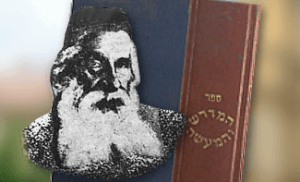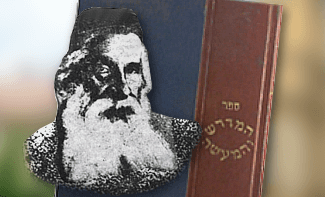
He placed the Tunic upon him and girdled him with the Sash; he dressed him in the Robe and placed the Ephod upon him[2].
The Kohanim who serve in the Beis HaMikdosh wear wool and linen exclusively.[3]
As is well known, the Rambam attempted to provide a rational basis for the Torah’s mitzvos – even the ones we understand to be chukim, which are by nature resistant to our attempts to grasp them. To explain the Torah’s prohibition against shatnez – a mixture of wool and linen – Rambam writes that such mixtures were the garments of choice of pagan priests, who wished to combine the plant (linen) with the animal (wool).[4]
Rambam’s position is puzzling, however. If this reasoning were behind the Torah’s prohibition, it should have banned wearing shatnez while performing religious rituals – which is what the pagan priests did – and permitted it for mundane use. We see in our parshah, however, that precisely the opposite is true. While the Torah forbids us to wear ordinary clothing of wool and linen, the garments of the kohanim were made of those materials alone!
Considering a recent trend in anti-religious thought, we might find a possible explanation of the Rambam.
For centuries, people distinguished between four realms of objects: inanimate, plant, animal, and human. While the last three shared certain properties – growth, death, decay – they differed in others, like feeling, will, free choice. Lately, however, it has become fashionable in some circles to deny the existence of will and free choice – anywhere. What seems to some people to be willful behavior or decision making is not essentially different from the behavior of inanimate objects that is simply the product of internal and external forces. All phenomena are governed by laws of nature, whether we understand them or not. The behavior of animals and humans may be more complicated that that of inanimate objects – and so are the forces that act upon them – but their behavior is really determined, whether by nature, or nurture, or both. Nothing stands outside the system of cause and effect. There is no room for freedom of the human will.
By denying that Man meaningfully makes any choices, they eliminate all moral responsibility. To them, there is no judgment – and there is no Judge.
It is hardly a new idea to place Nature at the apex of values. Many of the ancient pagans turned every phenomenon of Nature into another deity. Yet we would be hard pressed to find “worship” or “service” in such systems. To the contrary, there was nothing holy in such systems, not could there be. These beliefs denied the existence of anything standing above Nature – itself fixed, and unchanging – that made demands on humans and set limits for them. Devotees of such beliefs did not subject themselves to the demands of any transcendent being. To the contrary, they asserted that there were no rules, laws, or limits to human conduct.
Perhaps this is what Rambam had in mind when he spoke of the ancient priests who combined the plant with the animal. By doing so, they wished to make the point that there was no essential difference between plants and animals. What seems like willful behavior in animals is nothing but the product of different natural forces upon them. Behind an apparent difference between different domains lies an essential equivalence. Inanimate, animate – they are all the same.
Their combination of plant and animal was meant to lower the latter, making it more like the former. The Torah has us do the opposite. We constantly take the lower, and elevate it to become something higher. Thus, we too have an interest in combining plant and animal – for the opposite reason of the pagans. We try to lift the lower to the level of the higher. Therefore, combining wool and linen is forbidden in everyday use, but becomes laudable specifically in the realm of the spiritual – in the performance of mitzvos, through which we can catapult items from one level to the ones above.
A second kind of equivalence enjoys popularity today. People behold the terrible suffering of masses of human beings living in destitution and desperation, their lot made worse by the few fortunate rich and powerful figures who control the lives of the many. They react with disgust for this inequity, and devise what they believe to be the obvious solution. Let society assert the equivalence of all people! Let all share equally in what this planet offers us. Every person will produce to the best of his ability, and then claim the same portion as everyone else.
The advocates for treating all people the same way can look to the Torah for support. In many ways, the Torah assumes the role of advocate for the weak and downtrodden, calling upon the haves to meet the needs of the have-nots. Why, they ask, does the Torah not take the next logical step, and simply ban difference, creating equality in its place?
The Torah, in fact, addresses this point. “May there be no destitute among you!”[5] the Torah commands at the beginning of a parshah about giving to the needy. Yet it ends on a particularly pessimistic note. “For destitute people will not cease to exist within the Land.”[6] The Torah lets us know that differences between people are part of the human condition. Attempts to artificially erase them will not succeed. No utopian society will be built by pretending that all people are the same. The destitute will not cease to exist, at least not in pre-Messianic times. Because there can be no simple, facile solution to the problem of poverty, the Torah instructs us to address the destitution around us as best we can by opening our hand and giving generously to our brethren in distress. The Torah upholds the sanctity of private property, while at the same time limiting the rights of the rich and enhancing the position of the poor. (The utopian dreamers may be wrong – and dangerous – but at least their hearts are in the right place. Worse are those who take advantage of the powerlessness of the poor, and further rob and cheat them.)
Why it is that G-d should justify the differences between people seems to occupy a central position in the prophecy of Chabakuk. “I will stand upon my watch and take my place at the siege, and I will wait to see what He will speak to me, and what I can answer my reproof.”[7] Chazal[8] enlarge upon his words, picking up on the similarity between the word matzor/siege and tzor/figure, form. “This teaches that Chabakuk formed an image, and said to Hashem, ‘I will not budge until You answer me!’” The navi formed an image in his mind of a world of absolute equality, in which none would know the ravages of abject poverty. He became so focused on this utopian image that he could not move on! Is there anything He cannot do? Why has He allowed such inequality to exist and flourish?
Chazal continue. “HKBH responded to Chabakuk. ‘Whoever breaks his hatchet will come to me!’” (In your utopian vision, all are equal, everyone takes the same. In that case, what motivates a person to do his job? He will be fed regardless. Should a person break his hatchet, he will not even bother with the simple task of attempting to fix it. He will instead throw the problem on to the shoulders of his comrade – or on to G-d Himself!)
“Why do You allow me to see iniquity and You look at evil deeds, with robbery and injustice before me?”[9] (The navi accepts the impossibility of absolute equality. But he does not let up in his argument with Hashem. If there cannot be equality, why must its opposite exist? Why is power concentrated in the hands of the deceitful, or the powerful, or those lucky enough to be born into it.)
G-d responds. “You are a ben-Torah, and not an am ha-aretz.” (You are filled with the imagination of one moved by a dream of perfection. But you are not sufficiently familiar with the practical realities of real life.) “Write an alef on a tablet.” (Writing that letter will give you the answer you seek. Which alef? The first one in Chumash Vayikra, which is written smaller than the other letters. It tells us that when Hashem, as it were, descends to our world to speak with us, He reigns as king – but not as the elevated, supernal King. His kingship is sharply limited by the free will that He provided us human beings. Once He allows us the capacity to choose good and evil, the world will know much of the latter. Somehow, this serves a higher purpose. But Man’s freedom to choose implies – demands – room for evil to continue unopposed by Divine intervention.)
He demands of us that we oppose that evil, and compensate for it when we see it. If we were to ask Him, however, to wipe out the existence of evil in one Divine swoop, the price we would pay would be to become robots, not humans.


